“Supply chain issues”. It feels at no other time in recent history have we heard these words repeated so much. Complex, bottlenecked, fragmented. Our global supply chain is under intense and sustained pressure that isn’t lightening-up any time soon. There is no vertical that has remained untouched by bottlenecks and manufacturing shortages while global inflation hits record highs.
Due to these challenges, every business big and small needs to rethink its supply chains to create flexibility and improve efficiency and resilience. But how do you know if your retail supply chain needs a transformation? Many indicators contribute to this, including constant human errors during data entry, a lack of transparency between channels and systems, as well as too many silos both internal to the organization and within the customer journey. Finally the biggest indicator is a lack of strategy to determine the customer journey across multiple channels.
Let’s break down some signs that your supply chain processes need an integration transformation.
Errors (2998+)
Continuous data errors are an easy and common sign that your business needs an integration transformation. If a business is processing more than 25 orders per day or has an average order value of over $100, they may have difficulty keeping up with manual data entry across different systems and channels.
This breaking point will begin to have serious consequences on your business ability to cope with these errors in a timely and organized manner. Data errors will continue to plague your internal team and put a serious impact on your customer experience. Data integration and automation for simple manual processes can eliminate excessive time, money and efforts in fixing manual data entry errors.
By eliminating manual data entry, your small business will be able to keep up with the changing landscape faster, remain agile, and respond more effectively to customer needs.

2. If You Can’t See It, You Can’t Know Where It Is
Lack of visibility often plagues businesses of all sizes, both internally and business processes. The larger your organization grows the more applications, channels, systems and tools you will need to operate. Eventually, a spaghetti net of applications will be created for an order, product or customer information to go through from order to delivery.
Strategic thought must be put into how and why customer and product information goes through a particular process. Each business is unique and will inevitably have different business strategies and processes necessary to do business.
Often, businesses have a lack of visibility into where their orders, products, inventory and customer information is at any given moment. This can be disastrous on the customer experience that can be difficult to fix. Customers are wise and demand visibility on their orders at all steps of the process. If your business has a lack of visibility into channels and applications, This is a key indication that a data integration transformation is needed. Holistic data integration takes into account your entire business.
Merchants who succeed understand that data integration is not just a technical exercise but a business process exercise as well. And linking applications together allows for visibility across the entire organization. This way, finding issues, errors in customer data or updates to inventory stats is efficient and won’t affect the customer experience permanently.

3. Silos Belong On The Farm
The larger an organization grows, the more siloed information and data becomes. It’s a natural process that happens with scaling. There are some good reasons to keep things siloed and independent but often the trade off has a direct impact on business processes that affect the overall customer experience of customers. Having systems interconnected can vastly improve operational efficiency, reduce errors and enable your organization to give your customers a consistent experience. Sometimes within a siloed organization, the inventory management, and the eCommerce team do not have the same visibility into warehouse product counts, CRM, and billing information.
Due to this lack of integration, your customers will end up having a frustrating experience, as they will not be able to find out where their order is or whether a particular product they ordered is indeed out of stock when they contact customer service.
When you reach a certain point along your growth journey, the integration will no longer be an issue that you need to justify but will become an obvious choice for efficient operation. With this will come a better customer experience that keeps customers coming back knowing your business is trustworthy, communicative and reliable.
4. Strategy Above All Else
All of the above signs provide evidence that your business requires an integration transformation, but the most obvious sign is that Merchants fail to strategize their busines processes properly. Business strategy can be really tough, and when against the grain of the everyday, it can take a backseat. Unfortunately when making decisions about technology and applications, strategy has to be the first thought. People often confuse tactics with strategy, but understanding the difference between the two is the first step.
Your business and its processes are more complex than you may realize, and the ultimate goal is to have your technology stack expand with you as your business changes, allowing integration to facilitate meeting your overall business goals. This is why you should consider a robust integration strategy before committing to a technological solution or application.
Tying It All Together
If your retail business can identify with any of the above signs, you are ready for an integration transformation. Today’s current supply chain issues will continue to have an impact on all aspects of business for the foreseeable future.
In light of that knowledge, control what you can and introduce agile and scalable solutions into your business. In times of scale and disruption, you can rely on your integration to grow with you, allowing you to reduce manual data entry, increase visibility and maintain a consistent customer experience across all sales channels you operate in.
Our VL OMNI iPaaS integration platform empowers scaling businesses across the world to fully integrate and automate their key workflows between applications. We help Merchants deliver on customer demands without juggling multiple systems and using manual processes and workarounds.
Integrate your systems, channels, partners, and applications together in ways that matter most to your business. Plus, apply business rules directly to data transformations. This will enable you to put your customers first and consistently deliver a customer experience across all touchpoints.
 D365 Business Central
D365 Business Central Netsuite
Netsuite


